...
| Info | ||
|---|---|---|
| ||
In the downloadable ExcelWriter_Basic_Tutorials.zip, there is a completed template file located in CompleteFinancialReport/templates/Part2_Financial_Template.xlsx. |
...
1. Select the 9 cells in the percentage grid at the top of the worksheet (C4:E6).
2. Right click and select "Format Cells..."
3. Select "Percentage" on the Number tab.
4. Click OK
5. Select cells C12:F12, C17:F17, and C22:D22.
6. In the top tool bar, under the 'Number' tab, click the "$" to apply the currency format.
...
As ExcelTemplate populates the worksheet, the number format will be copied to all the new rows of data that are inserted where the data markers are.
Setting Styles
The next step is setting up the table. Add a header and label the rows and columns to end up with a complete table: 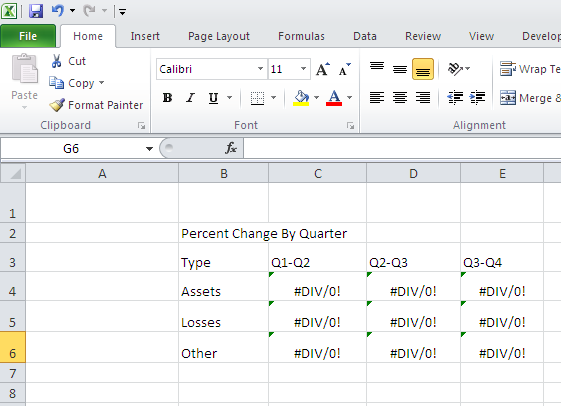
Once the table is complete, add styles.
1.Select "Percent Change by Quarter" and set it to "Heading 1." Heading 1 is found in the named styles list, on the "Home" tab of the ribbon.
2. Select the header row (B3:E3) and set it to "Total" in the named styles menu.
3. Select the row labels (B4:B6) and set that to "Total."
You should now have this:
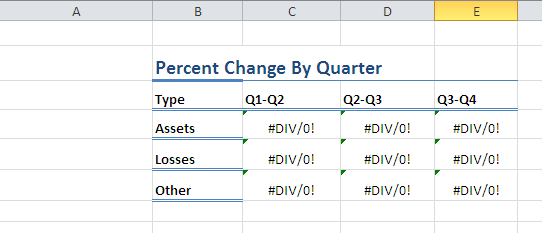
4. Select the area of B3:E6, and apply a consistent border:
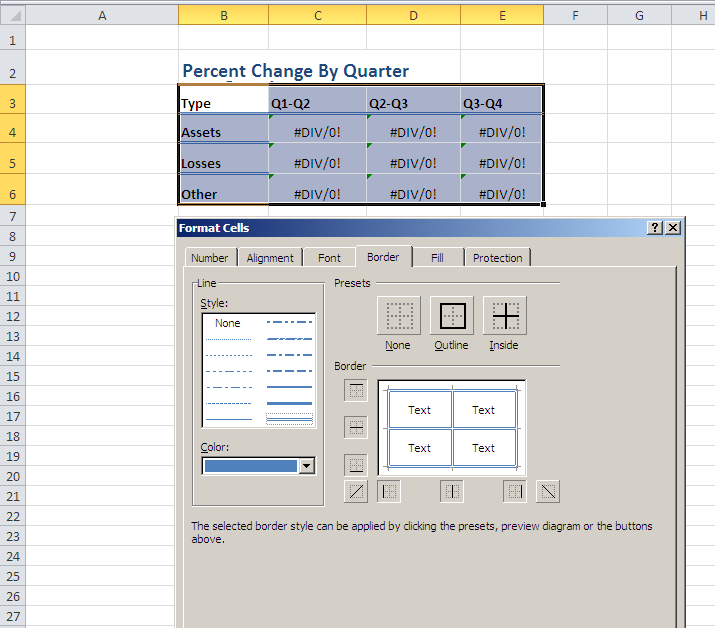
5. Now select B2:E2 and apply a bottom border in dark blue.
The template should look like this:
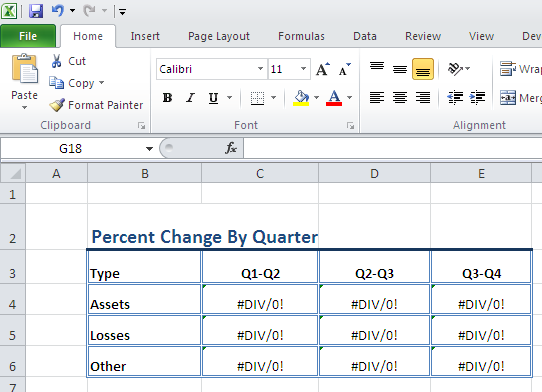
Conditional Formatting
...
Conditional Formatting
ExcelTemplate will preserve existing conditional formatting. If the conditional format includes a formula, that formula will also be updated as new rows are inserted into the file.
In this case, the conditional formatting will be applied to the 'percent table' and it format negative numbers to be bold and red.
1. On the "Home" tab in Excel, click on "Conditional Formatting"
...
5. Click OK to save the rule. 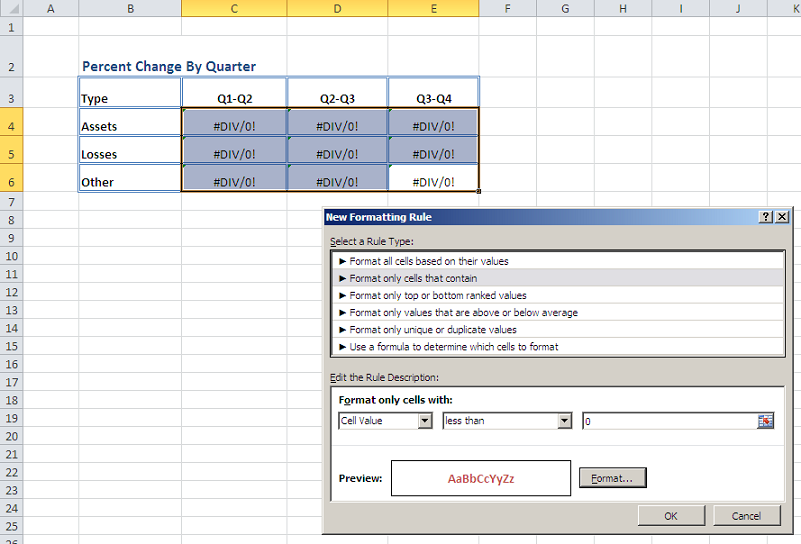
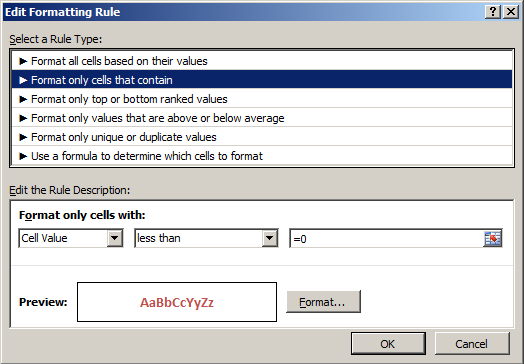
Adding an ExcelWriter Reference in Visual Studio
...
1. Include the SoftArtisans.OfficeWriter.ExcelWriter namespace in the code behind
| Code Block |
|---|
using SoftArtisans.OfficeWriter.ExcelWriter;
|
...
3. Open the template file with the ExcelTemplate.Open method.
| Code Block |
|---|
XLT.Open(Page.MapPath("//templates//Part2_Financial_Template.xlsx"));
|
4. Create a DataBindingProperties object. None of the binding properties will be changed for this tutorial, but DataBindingProperties is a required parameter in ExcelTemplate data binding methods.
| Code Block |
|---|
DataBindingProperties dataProps = XLT.CreateDataBindingProperties();
|
Data Binding
1.Get the data for the Assets, Losses, and Other datasets
| Info | ||
|---|---|---|
| ||
In the sample projectSimilarly to part 1, we are parsing CSV files with query results, rather than querying a live database. The CSV files are available under the data directory. There is a copy of the CSV parser, |
1.Get the data for the Assets, Losses, and Other datasets
These calls are to a helper method GetCSVData that parses the CSV files and returns a DataTable with the values.
If you are following in your own project and would like to parse the CSV files as well, you will need to:
...
| Code Block |
|---|
...
...
| Code Block |
|---|
DataTable dtAssets = GetCSVData("//data//Assets.csv");
DataTable dtLosses = GetCSVData("//data//Losses.csv");
DataTable dtOther = GetCSVData("//data//Other.csv");
|
2. Use ExcelTemplate.BindData to bind the data for the Assets, Losses, and Other data sets.
| Code Block |
|---|
XLT.BindData(dtAssets, "Assets", bindingProps);
XLT.BindData(dtLosses, "Losses", bindingProps);
XLT.BindData(dtOther, "Other", bindingProps);
|
3. Call ExcelTemplate.Process() to import all data into the file.
| Code Block |
|---|
XLT.Process();
|
4. Call ExcelTemplate.Save() to save the final file.
| Code Block |
|---|
XLT.Save(Page.Response, "temp.xlsx", false);
|
The final output should look something like this:
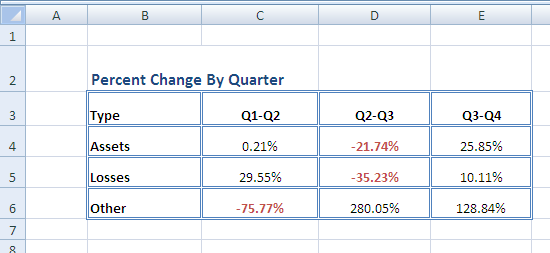
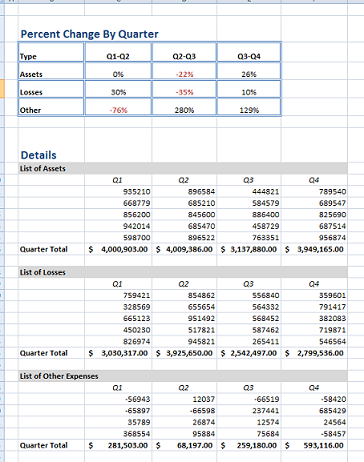
Final Code
| Code Block |
|---|
using SoftArtisans.OfficeWriter.ExcelWriter;
...
//Instantiate the template object
ExcelTemplate XLT = new ExcelTemplate();
//Open the file
XLT.Open(Page.MapPath("//templates//Part1_Financial_Template.xlsx"));
//Create data binding properties
DataBindingProperties bindingProps = XLT.CreateDataBindingProperties();
//Get the data from the CSVs. More info about the generic parser is available
//in the project and in the tutorial above.
DataTable dtAssets = GetCSVData("//data//Assets.csv");
DataTable dtLosses = GetCSVData("//data//Losses.csv");
DataTable dtOther = GetCSVData("//data//Other.csv");
//Bind each datatable
XLT.BindData(dtAssets, "Assets", bindingProps);
XLT.BindData(dtLosses, "Losses", bindingProps);
XLT.BindData(dtOther, "Other", bindingProps);
//Call process to import data to file
XLT.Process();
//Call save
XLT.Save(Page.Response, "temp.xlsx", false);
|
...
You can download the code for the Financial Report here.